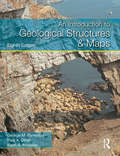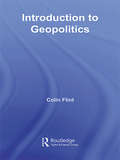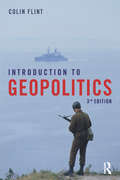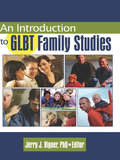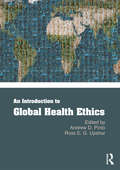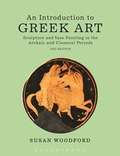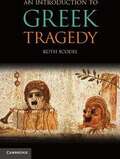- Table View
- List View
An Introduction to Games Studies: Games in Culture (PDF)
by Frans MayraAn Introduction to Game Studies is the first introductory textbook for students of game studies. It provides a conceptual overview of the cultural, social and economic significance of computer and video games and traces the history of game culture and the emergence of game studies as a field of research. Key concepts and theories are illustrated with discussion of games taken from different historical phases of game culture. Progressing from the simple, yet engaging gameplay of Pong and text-based adventure games to the complex virtual worlds of contemporary online games, the book guides students towards analytical appreciation and critical engagement with gaming and game studies. Students will learn to: Understand and analyse different aspects of phenomena we recognise as 'game' and play' Identify the key developments in digital game design through discussion of action in games of the 1970s, fiction and adventure in games of the 1980s, three-dimensionality in games of the 1990s, and social aspects of gameplay in contemporary online games Understand games as dynamic systems of meaning-making Interpret the context of games as 'culture' and subculture Analyse the relationship between technology and interactivity and between 'game' and 'reality' Situate games within the context of digital culture and the information society. With further reading suggestions, images, exercises, online resources and a whole chapter devoted to preparing students to do their own game studies project, An Introduction to Game Studies is the complete toolkit for all students pursuing the study of games. The companion website at www.sagepub.co.uk/mayra contains slides and assignments that are suitable for self-study as well as for classroom use. Students will also benefit from online resources at www.gamestudiesbook.net, which will be regularly blogged and updated by the author. Professor Frans Mayra is a Professor of Games Studies and Digital Culture at the Hypermedia Laboratory in the University of Tampere, Finland.
Introduction to Gender: Social Science Perspectives
by Jennifer Marchbank Gayle LetherbyThoroughly updated in this second edition, Introduction to Gender offers an interdisciplinary approach to the main themes and debates in gender studies. This comprehensive and contemporary text explores the idea of gender from the perspectives of history, sociology, social policy, anthropology, psychology, politics, pedagogy and geography and considers issues such as health and illness, work, family, crime and violence, and culture and media. Throughout the text, studies on masculinity are highlighted alongside essential feminist work, producing an integrated investigation of the field. Key features: A thematic structure provides a clear exploration of each debate without losing sight of the interconnections between disciplines. World in focus boxes and international case studies offer a broad global perspective on gender studies. In-text features and student exercises, including Controversy, A critical look and Stop and think boxes, allow the reader to engage in the debates and revise the material covered. Hotlinks throughout the text make connections between chapters, allowing the reader to follow the path of particular issues and debates between topics and disciplines. New to the second edition: A new chapter explores gender through the discipline of philosophy. A new section on international relations brings this relevant topic into focus. Current discussion on the language of gender across Europe is brought in to Chapter 1. A focus on Europe and Scandinavia as well as the UK gives the text a broader scope. Examples are updated throughout to ensure the text is cutting-edge and relevant. Introduction to Gender, second edition is highly relevant to today’s students across the social sciences and is an essential introduction for students of sociology, women’s studies and men’s studies.
Introduction to Gender: Social Science Perspectives
by Jennifer Marchbank Gayle LetherbyThoroughly updated in this second edition, Introduction to Gender offers an interdisciplinary approach to the main themes and debates in gender studies. This comprehensive and contemporary text explores the idea of gender from the perspectives of history, sociology, social policy, anthropology, psychology, politics, pedagogy and geography and considers issues such as health and illness, work, family, crime and violence, and culture and media. Throughout the text, studies on masculinity are highlighted alongside essential feminist work, producing an integrated investigation of the field. Key features: A thematic structure provides a clear exploration of each debate without losing sight of the interconnections between disciplines. World in focus boxes and international case studies offer a broad global perspective on gender studies. In-text features and student exercises, including Controversy, A critical look and Stop and think boxes, allow the reader to engage in the debates and revise the material covered. Hotlinks throughout the text make connections between chapters, allowing the reader to follow the path of particular issues and debates between topics and disciplines. New to the second edition: A new chapter explores gender through the discipline of philosophy. A new section on international relations brings this relevant topic into focus. Current discussion on the language of gender across Europe is brought in to Chapter 1. A focus on Europe and Scandinavia as well as the UK gives the text a broader scope. Examples are updated throughout to ensure the text is cutting-edge and relevant. Introduction to Gender, second edition is highly relevant to today’s students across the social sciences and is an essential introduction for students of sociology, women’s studies and men’s studies.
Introduction to Geographical Information Systems
by Ian Heywood Sarah Cornelius Steve CarverThe full text downloaded to your computer With eBooks you can: search for key concepts, words and phrases make highlights and notes as you study share your notes with friends eBooks are downloaded to your computer and accessible either offline through the Bookshelf (available as a free download), available online and also via the iPad and Android apps. Upon purchase, you'll gain instant access to this eBook. Time limit The eBooks products do not have an expiry date. You will continue to access your digital ebook products whilst you have your Bookshelf installed. The 4th Edition of this highly regarded and successful text continues to provide a clear and accessible introduction to the world of GIS for students and professionals. With an increased focus on the practical applications of GIS, the new edition features a wealth of new multi-disciplinary case studies and examples of GIS in practice, demonstrating how it is used worldwide and within a variety of different industries. Furthermore, the new edition has been substantially revised and updated to include coverage of the latest advances in GIS such as web and mobile applications. An Introduction to Geographical Information Systems is suitable for students of Geographical Information studies at all levels, from undergraduate to professionals retraining in GIS.
An Introduction to Geological Structures and Maps, Eighth Edition
by George M Bennison Paul A Olver Keith A MoseleyAn Introduction to Geological Structures and Maps is a concise and accessible textbook providing simple structural terminology and map problems which introduce geological structures. It is a perfect introduction to mapping for students of geology, engineering geology and civil engineering.Each topic is explained and illustrated by figures, and exercises follow on successive maps. If students are unable to complete an exercise, they can read on to obtain more specific instructions on how theory may be used to solve the problem. An appendix at the end of the book provides the solutions.This new, eighth edition contains simplified introductory matter to make the subject as easy to grasp as possible. Colour photographs illustrating geological structures bring the subject to life and a new map from the British Geological Survey illustrates a real area. There is more on outcrop patterns, which will help students to think in 3D, and on structures and the relationship of topography to geological structure. Cliff sections have been added to reinforce the concept of apparent dip. The section on planetary geology has been more closely tied to igneous geology to aid understanding of the connection between the two. Finally, a new map on economic geology has been added for the benefit of engineering students.A geological glossary helps students to understand and memorise key terms and a new, colourful, text design enlivens the appearance of this popular book.
An Introduction to Geological Structures and Maps, Eighth Edition
by George M Bennison Paul A Olver Keith A MoseleyAn Introduction to Geological Structures and Maps is a concise and accessible textbook providing simple structural terminology and map problems which introduce geological structures. It is a perfect introduction to mapping for students of geology, engineering geology and civil engineering.Each topic is explained and illustrated by figures, and exercises follow on successive maps. If students are unable to complete an exercise, they can read on to obtain more specific instructions on how theory may be used to solve the problem. An appendix at the end of the book provides the solutions.This new, eighth edition contains simplified introductory matter to make the subject as easy to grasp as possible. Colour photographs illustrating geological structures bring the subject to life and a new map from the British Geological Survey illustrates a real area. There is more on outcrop patterns, which will help students to think in 3D, and on structures and the relationship of topography to geological structure. Cliff sections have been added to reinforce the concept of apparent dip. The section on planetary geology has been more closely tied to igneous geology to aid understanding of the connection between the two. Finally, a new map on economic geology has been added for the benefit of engineering students.A geological glossary helps students to understand and memorise key terms and a new, colourful, text design enlivens the appearance of this popular book.
Introduction to Geopolitics
by Colin FlintThis clear and concise introductory textbook guides students through their first engagement with geopolitics. It offers a clear framework for understanding contemporary conflicts by showing how geography provides opportunities and limits upon the actions of countries, national groups, and terrorist organizations, and the overarching theme of geopolitical structures and agents requires no previous knowledge of theory or current affairs. Throughout the book, case studies, including the rise of al Qaeda, the Korean conflict, Israel-Palestine, Chechnya and Kashmir, emphasize the multi-faceted nature of conflict. These, along with guided exercises, help explain contemporary global power struggles, the global military actions of the United States, the persistence of nationalist conflicts, the changing role of borders, and the new geopolitics of terrorism. Throughout, the readers are introduced to different theoretical perspectives, including feminist contributions, as both the practice and representation of geopolitics are discussed. Introduction to Geopolitics is extensively illustrated with diagrams, maps, and photographs. Reading this book will provide a deeper and critical understanding of current affairs and facilitate access to higher level course work and essays on geopolitics. Both students and general readers alike will find this book an essential stepping-stone to understanding contemporary conflicts.
Introduction to Geopolitics
by Colin FlintThis clear and concise introductory textbook guides students through their first engagement with geopolitics. It offers a clear framework for understanding contemporary conflicts by showing how geography provides opportunities and limits upon the actions of countries, national groups, and terrorist organizations, and the overarching theme of geopolitical structures and agents requires no previous knowledge of theory or current affairs. Throughout the book, case studies, including the rise of al Qaeda, the Korean conflict, Israel-Palestine, Chechnya and Kashmir, emphasize the multi-faceted nature of conflict. These, along with guided exercises, help explain contemporary global power struggles, the global military actions of the United States, the persistence of nationalist conflicts, the changing role of borders, and the new geopolitics of terrorism. Throughout, the readers are introduced to different theoretical perspectives, including feminist contributions, as both the practice and representation of geopolitics are discussed. Introduction to Geopolitics is extensively illustrated with diagrams, maps, and photographs. Reading this book will provide a deeper and critical understanding of current affairs and facilitate access to higher level course work and essays on geopolitics. Both students and general readers alike will find this book an essential stepping-stone to understanding contemporary conflicts.
Introduction to Geopolitics
by Colin FlintThis new updated edition of Introduction to Geopolitics presents the overarching themes of geopolitical structures and agents in an engaging and accessible manner, which requires no previous knowledge of theory or current affairs. Using new pertinent case studies and guided exercises the title explains the contemporary global power of the United States and the challenges it is facing, the persistence of nationalist conflicts, migration, cyberwar, terrorism, and environmental geopolitics. Case studies of the rise of the so-called Islamic State, the South China Sea disputes, the Syrian civil war, the Korean conflict, and Israel-Palestine emphasize the multi-faceted nature of conflict. The book raises questions by incorporating international and long term historical perspectives and introduces readers to different theoretical viewpoints, including feminist contributions. The new edition features expanded sections on network geopolitics and non-state actors, a new section on geopolitics of transnational business, cyberwar, an interpretation of ISIS within historical geopolitical trends, as well as expanded discussion of the relevance of Boserup and neo-Malthusians to environmental geopolitics. Introduction to Geopolitics will provide its readers with a set of critical analytical tools for understanding the actions of states as well as non-state actors acting in competition over resources and power. Both students and general readers will find this book an essential stepping-stone to a deeper and critical understanding of contemporary conflicts.
Introduction to Geopolitics
by Colin FlintThis new updated edition of Introduction to Geopolitics presents the overarching themes of geopolitical structures and agents in an engaging and accessible manner, which requires no previous knowledge of theory or current affairs. Using new pertinent case studies and guided exercises the title explains the contemporary global power of the United States and the challenges it is facing, the persistence of nationalist conflicts, migration, cyberwar, terrorism, and environmental geopolitics. Case studies of the rise of the so-called Islamic State, the South China Sea disputes, the Syrian civil war, the Korean conflict, and Israel-Palestine emphasize the multi-faceted nature of conflict. The book raises questions by incorporating international and long term historical perspectives and introduces readers to different theoretical viewpoints, including feminist contributions. The new edition features expanded sections on network geopolitics and non-state actors, a new section on geopolitics of transnational business, cyberwar, an interpretation of ISIS within historical geopolitical trends, as well as expanded discussion of the relevance of Boserup and neo-Malthusians to environmental geopolitics. Introduction to Geopolitics will provide its readers with a set of critical analytical tools for understanding the actions of states as well as non-state actors acting in competition over resources and power. Both students and general readers will find this book an essential stepping-stone to a deeper and critical understanding of contemporary conflicts.
Introduction to Geopolitics
by Colin FlintThis new updated edition presents the overarching themes of geopolitical structures and agents in an engaging and accessible manner, which requires no previous knowledge of theory or current affairs. It helps readers understand the geopolitical implications of COVID-19, China’s pronounced role in the world, the relative decline of the US, and the Black Lives Matter movement. Using new pertinent case studies and guided exercises, the title explains the contemporary global power of the United States and the challenges it is facing, the changing foreign policy of China and other countries, the persistence of nationalist conflicts, migration, cyberwar and cyberactivism, terrorism, energy geopolitics, and environmental geopolitics. Expanded case studies of the South China Sea disputes and China’s Belt and Road Initiative emphasize the multi-faceted nature of conflict. The book raises questions by incorporating international and long-term historical perspectives and introduces readers to different theoretical viewpoints, including feminist contributions. The new edition features fresh discussion of island geopolitics, the Anthropocene age, and geoeconomics. Introduction to Geopolitics will provide its readers with a set of critical analytical tools for understanding the actions of states as well as non-state actors acting in competition over resources and power. Both students and general readers will find this book an essential stepping-stone to a deeper and critical understanding of contemporary conflicts. The companion website will enable readers to apply the themes of the book to the constant shifts in current affairs to enable deeper understanding. It will provide access to weekly essays showing how the themes explain current events.
Introduction to Geopolitics
by Colin FlintThis new updated edition presents the overarching themes of geopolitical structures and agents in an engaging and accessible manner, which requires no previous knowledge of theory or current affairs. It helps readers understand the geopolitical implications of COVID-19, China’s pronounced role in the world, the relative decline of the US, and the Black Lives Matter movement. Using new pertinent case studies and guided exercises, the title explains the contemporary global power of the United States and the challenges it is facing, the changing foreign policy of China and other countries, the persistence of nationalist conflicts, migration, cyberwar and cyberactivism, terrorism, energy geopolitics, and environmental geopolitics. Expanded case studies of the South China Sea disputes and China’s Belt and Road Initiative emphasize the multi-faceted nature of conflict. The book raises questions by incorporating international and long-term historical perspectives and introduces readers to different theoretical viewpoints, including feminist contributions. The new edition features fresh discussion of island geopolitics, the Anthropocene age, and geoeconomics. Introduction to Geopolitics will provide its readers with a set of critical analytical tools for understanding the actions of states as well as non-state actors acting in competition over resources and power. Both students and general readers will find this book an essential stepping-stone to a deeper and critical understanding of contemporary conflicts. The companion website will enable readers to apply the themes of the book to the constant shifts in current affairs to enable deeper understanding. It will provide access to weekly essays showing how the themes explain current events.
An Introduction To Gerontology (PDF)
by Ian Stuart-HamiltonWith the world's population getting increasingly older, there has never been a more pressing need for the study of old age and ageing. An Introduction to Gerontology provides a wide-ranging introduction to this important topic. By assuming no prior expert knowledge and avoiding jargon, this book will guide students through all the main subjects in gerontology, covering both traditional areas, such as biological and social ageing, as well as more contemporary areas, such as technology, the arts, sexuality and education of older adults. An Introduction to Gerontology is written by a team of international authors with multidisciplinary backgrounds who draw evidence from a variety of different perspectives and traditions.
An Introduction to GLBT Family Studies
by J Jerry BignerGain a better understanding of the special therapeutic issues and needs of GLBT familiesIn terms of research, GLBT families constitute a neglected segment of society. Gender and sexual orientation can make the issues in family studies even more difficult to work through. An Introduction to GLBT Family Studies tackles a challenging research topic by presenting noted experts examining the latest information on the newest type of family studies-GLBT families. This groundbreaking text explores a wide range of unique problems faced by nontraditional families, as well as issues common to traditional families that need to be approached with a GLBT perspective.Though homophobia and heterosexism constantly influence GLBT families, these factors do not necessarily overwhelm the dynamic of their basic family unit. Issues present in many traditional families are found when researching GLBT families. An Introduction to GLBT Family Studies spotlights the issues, research, and future trends that provide a foundation for the study of GLBT families. This breakthrough volume focuses not only on the obvious unique factors within GLBT families, but also on the elements encountered within families that are present regardless of sexual orientation and gender, such as physical and emotional abuse. Expert contributors present research findings on family pattern issues relating to parent-child relationships, child development, sibling relationships, family structure, intimate relationships, stepfamilies, alternative family structures, and extended family relationships. Each chapter is extensively referenced and offers possibilities for further research. An Introduction to GLBT Family Studies discusses family studies topics such as: the impact of the family of origin life course perspective transgender identity issues and the family when a spouse comes out as gay, lesbian, or bisexual a study of lesbian couples adapting genogram techniques in therapy research comparing siblings of different sexual orientations studies of patterns of responses to parental reactions to learning their offspring are gay, lesbian, or bisexual the polyamory structure to some gay men&’s familial relationships same-sex marriages and legalized relationships gay male couples&’ roles in today&’s society the impact of heterosexism on working with same-sex relationships research on long-term lesbian couplesAn Introduction to GLBT Family Studies is a valuable reference for academic researchers in family studies, marriage and family therapy, social work, and counseling; educators, upper division undergraduate and graduate students; and anyone interested in better understanding GLBT family studies.
An Introduction to GLBT Family Studies
by J Jerry BignerGain a better understanding of the special therapeutic issues and needs of GLBT familiesIn terms of research, GLBT families constitute a neglected segment of society. Gender and sexual orientation can make the issues in family studies even more difficult to work through. An Introduction to GLBT Family Studies tackles a challenging research topic by presenting noted experts examining the latest information on the newest type of family studies-GLBT families. This groundbreaking text explores a wide range of unique problems faced by nontraditional families, as well as issues common to traditional families that need to be approached with a GLBT perspective.Though homophobia and heterosexism constantly influence GLBT families, these factors do not necessarily overwhelm the dynamic of their basic family unit. Issues present in many traditional families are found when researching GLBT families. An Introduction to GLBT Family Studies spotlights the issues, research, and future trends that provide a foundation for the study of GLBT families. This breakthrough volume focuses not only on the obvious unique factors within GLBT families, but also on the elements encountered within families that are present regardless of sexual orientation and gender, such as physical and emotional abuse. Expert contributors present research findings on family pattern issues relating to parent-child relationships, child development, sibling relationships, family structure, intimate relationships, stepfamilies, alternative family structures, and extended family relationships. Each chapter is extensively referenced and offers possibilities for further research. An Introduction to GLBT Family Studies discusses family studies topics such as: the impact of the family of origin life course perspective transgender identity issues and the family when a spouse comes out as gay, lesbian, or bisexual a study of lesbian couples adapting genogram techniques in therapy research comparing siblings of different sexual orientations studies of patterns of responses to parental reactions to learning their offspring are gay, lesbian, or bisexual the polyamory structure to some gay men&’s familial relationships same-sex marriages and legalized relationships gay male couples&’ roles in today&’s society the impact of heterosexism on working with same-sex relationships research on long-term lesbian couplesAn Introduction to GLBT Family Studies is a valuable reference for academic researchers in family studies, marriage and family therapy, social work, and counseling; educators, upper division undergraduate and graduate students; and anyone interested in better understanding GLBT family studies.
An Introduction to Global Environmental Issues Instructors Manual
by Lewis A. Owen Professor Kevin Pickering Kevin T. PickeringAn Introduction to Global Environmental Issues presents a comprehensive stimulating introduction to the key environmental issues presently threatening our global environment. Offering an authoritative introduction to the key topics, a source of latest environmental information, and an innovative stimulus for debate, this is an essential book for all those studying or concerned with global environmental issues. In this second edition, the most topical global environmental issues are brought more clearly into focus. Explanations of the evolution of the earth's natural systems (hydrosphere, biosphere, geosphere, ecosphere) provide the essential understanding of the scientific concepts, processes and historical background behind key environmental issues. Contemporary socio-economic, cultural and political considerations are explored and important conceptual approaches such as Gaian hypotheses and Chaos Theory are introduced. Human impact and management of the natural environment, and concerns for maintaining biodiversity are emphasised throughout. Specific features include: * Case studies drawn from across the world * Superb illustrations: 4-colour plate sections; a wealth of informative diagrams * Glossary of key terms, with key concepts highlighted throughout the text * Annotated guides to Further Reading * Chapter summaries and key points A new Instructors' Manual is available to accompany the text
An Introduction to Global Health Delivery: Practice, Equity, Human Rights
by Joia MukherjeeIn the last two decades, the rise of global health studies at universities across the world reflects the interest of a growing generation of students motivated to be involved in progressive global change. Grassroots advocacy for health equity and strong leadership in the global South have catalyzed a paradigm shift from primarily preventative health programs to holistic systems providing health care as a human right. To succeed in this field, students must not only understand the elements needed to deliver equitable health care but also the historical and social factors that cause and propagate health disparities. An Introduction to Global Health Delivery, Second Edition is an immersive introduction to global health's origins, actors, interventions, and challenges from the ongoing impacts of racism to the momentum for the delivery of care that began with the AIDS movement through to the current era of COVID-19. Informed by physician Joia Mukherjee's quarter-century of experience fighting disease and poverty in more than a dozen countries, it delivers a clear-eyed overview of the movement underway to address injustice, reduce global health disparities, and deliver health care as a human right. This second edition extends the lens of global health delivery to address the challenges of COVID-19 and the prevention of future pandemics. It features updated chapters exploring pandemics, preparedness, and the intersection of key social movements with the right to health care, including Black Lives Matter, decolonization, and climate justice. Enriched with case studies and exercises that encourage readers to think critically about equitable global health delivery, An Introduction to Global Health Delivery, Second Edition is the essential starting point for readers of any background seeking a practical grounding in global health's promise and progress.
An Introduction to Global Health Delivery: Practice, Equity, Human Rights
by Joia MukherjeeIn the last two decades, the rise of global health studies at universities across the world reflects the interest of a growing generation of students motivated to be involved in progressive global change. Grassroots advocacy for health equity and strong leadership in the global South have catalyzed a paradigm shift from primarily preventative health programs to holistic systems providing health care as a human right. To succeed in this field, students must not only understand the elements needed to deliver equitable health care but also the historical and social factors that cause and propagate health disparities. An Introduction to Global Health Delivery, Second Edition is an immersive introduction to global health's origins, actors, interventions, and challenges from the ongoing impacts of racism to the momentum for the delivery of care that began with the AIDS movement through to the current era of COVID-19. Informed by physician Joia Mukherjee's quarter-century of experience fighting disease and poverty in more than a dozen countries, it delivers a clear-eyed overview of the movement underway to address injustice, reduce global health disparities, and deliver health care as a human right. This second edition extends the lens of global health delivery to address the challenges of COVID-19 and the prevention of future pandemics. It features updated chapters exploring pandemics, preparedness, and the intersection of key social movements with the right to health care, including Black Lives Matter, decolonization, and climate justice. Enriched with case studies and exercises that encourage readers to think critically about equitable global health delivery, An Introduction to Global Health Delivery, Second Edition is the essential starting point for readers of any background seeking a practical grounding in global health's promise and progress.
An Introduction to Global Health Ethics
by Andrew D. Pinto Ross E. UpshurThe field of global health is expanding rapidly. An increasing number of trainees are studying and working with marginalized populations, often within low and middle-income countries. Such endeavours are beset by ethical dilemmas: mitigating power differentials, addressing cultural differences in how health and illness are viewed, and obtaining individual and community consent in research. This introductory textbook supports students to understand and work through key areas of concern, assisting them in moving towards a more critical view of global health practise. Divided into two sections covering the theory and practice of global health ethics, the text begins by looking at definitions of global health and the field’s historical context. It draws on anti-colonial perspectives concepts, developing social justice and solidarity as key principles to guide students. The second part focuses on ethical challenges students may face in clinical experiences or research. Topics such as working with indigenous communities, the politics of global health governance, and the ethical challenges of advocacy are explored using a case study approach. An Introduction to Global Health Ethics includes recommended resources and further readings, and is ideal for students from a range of disciplines – including public health, medicine, nursing, law and development studies – who are undertaking undergraduate and graduate courses in ethics or placements overseas.
An Introduction to Global Health Ethics
by Andrew D. Pinto Ross E. UpshurThe field of global health is expanding rapidly. An increasing number of trainees are studying and working with marginalized populations, often within low and middle-income countries. Such endeavours are beset by ethical dilemmas: mitigating power differentials, addressing cultural differences in how health and illness are viewed, and obtaining individual and community consent in research. This introductory textbook supports students to understand and work through key areas of concern, assisting them in moving towards a more critical view of global health practise. Divided into two sections covering the theory and practice of global health ethics, the text begins by looking at definitions of global health and the field’s historical context. It draws on anti-colonial perspectives concepts, developing social justice and solidarity as key principles to guide students. The second part focuses on ethical challenges students may face in clinical experiences or research. Topics such as working with indigenous communities, the politics of global health governance, and the ethical challenges of advocacy are explored using a case study approach. An Introduction to Global Health Ethics includes recommended resources and further readings, and is ideal for students from a range of disciplines – including public health, medicine, nursing, law and development studies – who are undertaking undergraduate and graduate courses in ethics or placements overseas.
An Introduction to Global Media for the Twenty-First Century
by Ole J. MjøsAn Introduction to Global Media for the Twenty-First Century provides a thorough introduction to the field of global media today. The book presents the key changes taking place as the global media landscape evolves, and the main theories of the field, that explain these developments.Tracing, first, the formative development of an international and global media landscape throughout the 20th century from the telegraph, television and film export, and transnational television to the Internet, the book then focuses on developments in the 21st century. This includes: the digitization of the global media and communications sector; the popularization of the Internet and digital infrastructure such as the smartphone and platforms; the emergence of global online media and services; the production and distribution of digital media content; and the exploitation of user data. Case studies illustrate key developments throughout the book.The book shows how the field is characterized by a continuity of critical concerns in relation to power, influence, and domination; media user empowerment and exploitation; and social and sustainable development and democratic conditions, as well as geopolitical shifts, in a global context.
An Introduction to Global Media for the Twenty-First Century
by Ole J. MjøsAn Introduction to Global Media for the Twenty-First Century provides a thorough introduction to the field of global media today. The book presents the key changes taking place as the global media landscape evolves, and the main theories of the field, that explain these developments.Tracing, first, the formative development of an international and global media landscape throughout the 20th century from the telegraph, television and film export, and transnational television to the Internet, the book then focuses on developments in the 21st century. This includes: the digitization of the global media and communications sector; the popularization of the Internet and digital infrastructure such as the smartphone and platforms; the emergence of global online media and services; the production and distribution of digital media content; and the exploitation of user data. Case studies illustrate key developments throughout the book.The book shows how the field is characterized by a continuity of critical concerns in relation to power, influence, and domination; media user empowerment and exploitation; and social and sustainable development and democratic conditions, as well as geopolitical shifts, in a global context.
An Introduction To Greek Art: Sculpture And Vase Painting In The Archaic And Classical Periods (PDF)
by Susan WoodfordThe four centuries between the composition of the Homeric epics and the conquests of Alexander the Great witnessed an immensely creative period in Greek art, one full of experimentation and innovation. But time has taken its toll; damaged statues have lost their colour and wall paintings have been totally destroyed. And yet sympathetic study of surviving sculpture and of drawing on vases can give extraordinary insight into and appreciation of these once brilliant works This book, designed originally for students, introduces the reader to Greek sculpture and vase painting in the critical period from the eighth to the fourth centuries BC. The works discussed are generously illustrated and lucidly analysed to give a vivid picture of the splendor of Greek art. The up-dated second edition includes a new chapter examining art in Greek society, a timeline to help relate artistic development to historical events, an explanation of how dates BC are arrived at, a brief overview of Greek temple plans and a further reading list of recent books. This clear, approachable and rigorous introduction makes the beauty of Greek art more readily accessible and comprehensible, balancing description with interpretation and illustration, and is an invaluable tool to help develop insight, appreciation and comprehension.
An Introduction To Greek Tragedy
by Ruth ScodelThis book provides an accessible introduction for students and anyone interested in increasing their enjoyment of Greek tragic plays. Whether readers are studying Greek culture, performing a Greek tragedy, or simply interested in reading a Greek play, this book will help them to understand and enjoy this challenging and rewarding genre. An Introduction to Greek Tragedy provides background information, helps readers appreciate, enjoy and engage with the plays themselves, and gives them an idea of the important questions in current scholarship on tragedy. Ruth Scodel seeks to dispel misleading assumptions about tragedy, stressing how open the plays are to different interpretations and reactions. In addition to general background, the book also includes chapters on specific plays, both the most familiar titles and some lesser-known plays - Persians, Helen and Orestes - in order to convey the variety that the tragedies offer readers.
An Introduction to Green Criminology and Environmental Justice
by Dr Angus NurseA comprehensive introduction to green criminology, this book is a discussion of the relationship between mainstream criminal justice and green crimes. Focused on environmental harm within the context of criminal justice this book takes a global perspective and Introduces students to different theoretical perspectives in green criminology Looks at the victims of environmental crime throughout Covers topics such as; wildlife crimes, animal abuse, the causes of environmental crime, regulation, exploitation, environmental activism, policing, prosecution and monitoring. Designed to help readers develop a thorough understanding of the principles of environmental justice and green criminology, as well as contemporary developments, this book will be excellent support to students of green criminology and environmental crime.




